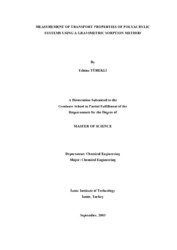Please use this identifier to cite or link to this item:
https://hdl.handle.net/11147/3446Full metadata record
| DC Field | Value | Language |
|---|---|---|
| dc.contributor.advisor | Alsoy Altınkaya, Sacide | - |
| dc.contributor.author | Yürekli, Yılmaz | - |
| dc.date.accessioned | 2014-07-22T13:51:33Z | - |
| dc.date.available | 2014-07-22T13:51:33Z | - |
| dc.date.issued | 2003 | - |
| dc.identifier.uri | http://hdl.handle.net/11147/3446 | - |
| dc.description | Thesis (Master)--Izmir Institute of Technology, Chemical Engineering, Izmir, 2003 | en_US |
| dc.description | Includes bibliographical references (leaves: 64-66) | en_US |
| dc.description | Text in English; Abstract: Turkish and English | en_US |
| dc.description | x, 66 leaves | en_US |
| dc.description.abstract | In this study, transport properties of methyl methacrylate (MMA) monomer in methylmethacrylate.butylacrylate copolymer were measured using a gravimetric sorption technique. This copolymer is used as a binder in indoor and outdoor paint formulation. Following the application of the paint material, residual monomers (volatile organic compounds, VOC) are emitted over time. Thus, it is important to understand and determine emission characteristics of residual monomers in order to evaluate their impact on the indoor air quality. With the growing awareness of the problems associated with the indoor air quality, there is now strong pressure for manufacturing, and selecting paint materials as well as other building materials with low VOC emissions. Success in both manufacturing and choosing environmentally friendly building materials is greatly facilitated by the availability of mathematical models for predicting the emission rates of VOCs from these materials. Emission rates of monomers, VOCs, from paint and other building materials are primarily governed by the diffusion within the material. The key parameter required to predict emission rates is the diffusion coefficient of monomers within the polymer. In addition, the knowledge of diffusivity of monomers in the polymer is prerequisite in the design of a devolatilization unit to produce paint materials with reduced monomer contents. In accordance with these concerns, the second objective of this study was to derive a physical model to predict the emission characteristics of the MMA from the paint material using experimentally determined diffusivity and solubility data.As a first step in the experimental study, MMA-BA copolymer sample was characterized to determine its glass transition temperature, degradation temperature, functional groups and composition using thermal analysis, fourier transform infrared spectroscopy and nuclear magnetic resonance analysis techniques. Samples were provided by Organic Kimya A.Ş. in the form of an emulsion and films were prepared using a film applicator. Final characterization of the samples was done by observing microstructure of the films and measuring the thickness using a scanning electron microscope.Diffusivity and solubilities were measured over a temperature range of 40 oC to 60 oC by a new type of gravimetric sorption apparatus called magnetic suspension balance. In order to determine concentration dependence of the diffusivities, monomer temperature was increased with small step changes. Diffusivity of MMA in MMA-BA copolymer varied in the range of 1x10-8 -1x10-7 cm2/s as the weight fraction of MMA increased from 0.03 to 0.2.The most popular theory derived by Vrentas and Duda was successfully used to correlate the diffusivity data of the MMA as a function of temperature and concentration. The free volume parameters were obtained by rheological measurements and with the use of limited diffusion data. Based on these parameters, the predictive ability of the model was found to be satisfactory. The solubility data were accurately modeled by Flory Huggins thermodynamic theory. The Flory Huggins interaction parameter determined as 0.726 indicated that MMA cannot completely dissolve the copolymer. According to the prediction of this theory, maximum amount of MMA which can be absorbed in the copolymer is around 53 % by volume.In the second part of this study, the physical model derived was used to predict MMA concentration in air under different conditions. Model predictions have shown that increasing air exchange rate significantly reduce the concentration of MMA in air.If the exchange rate is not changed, increasing air velocity or temperature causes an increase in MMA concentration in air. In all cases, at long emission times concentration of MMA in the paint material does not change significantly indicating that transport of MMA is controlled by diffusion in the paint material. | en_US |
| dc.language.iso | en | en_US |
| dc.publisher | Izmir Institute of Technology | en_US |
| dc.rights | info:eu-repo/semantics/openAccess | en_US |
| dc.subject.lcc | TP247. Y87 2003 | en |
| dc.subject.lcsh | Monomers | en |
| dc.subject.lcsh | Diffusion | en |
| dc.subject.lcsh | Solvents | en |
| dc.subject.lcsh | Copolymers | en |
| dc.title | Measurement of Transport Properties of Polyacrylic Systems Using a Gravimetric Sorption Method | en_US |
| dc.type | Master Thesis | en_US |
| dc.institutionauthor | Yürekli, Yılmaz | - |
| dc.department | Thesis (Master)--İzmir Institute of Technology, Chemical Engineering | en_US |
| dc.relation.publicationcategory | Tez | en_US |
| dc.identifier.wosquality | N/A | - |
| dc.identifier.scopusquality | N/A | - |
| item.openairecristype | http://purl.org/coar/resource_type/c_18cf | - |
| item.cerifentitytype | Publications | - |
| item.fulltext | With Fulltext | - |
| item.languageiso639-1 | en | - |
| item.grantfulltext | open | - |
| item.openairetype | Master Thesis | - |
| Appears in Collections: | Master Degree / Yüksek Lisans Tezleri | |
Files in This Item:
| File | Description | Size | Format | |
|---|---|---|---|---|
| T000274.pdf | MasterThesis | 1.64 MB | Adobe PDF |  View/Open |
CORE Recommender
Page view(s)
250
checked on Apr 28, 2025
Download(s)
108
checked on Apr 28, 2025
Google ScholarTM
Check
Items in GCRIS Repository are protected by copyright, with all rights reserved, unless otherwise indicated.